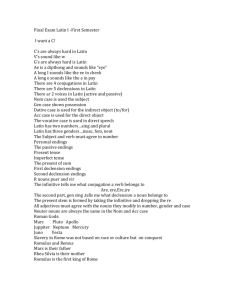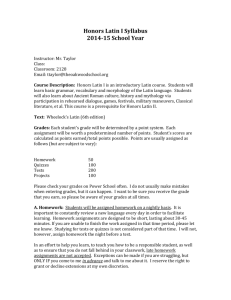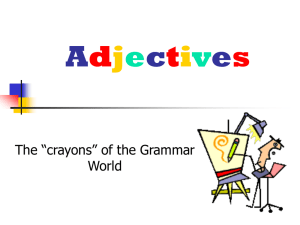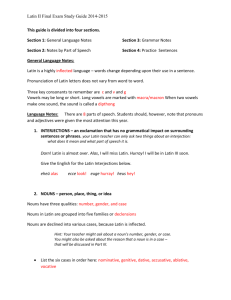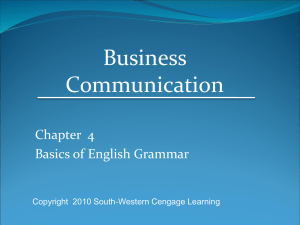Class_26
advertisement
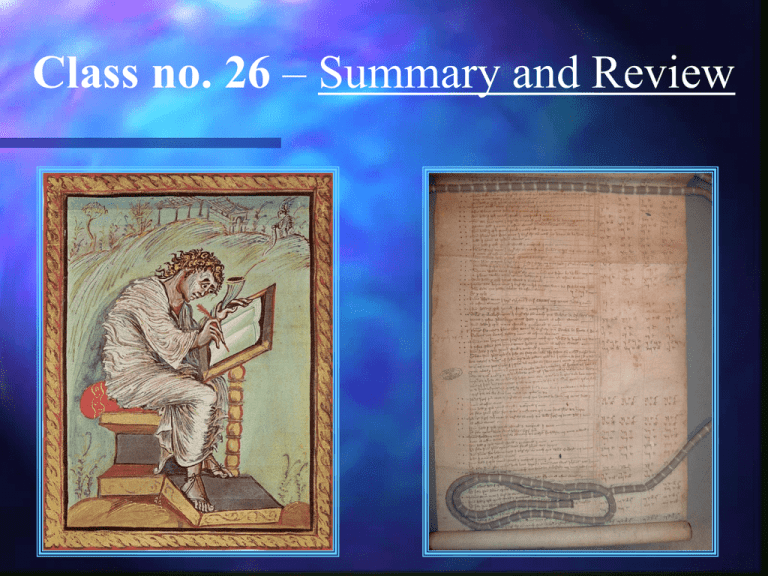
Class no. 26 – Summary and Review Document no. 19 1740 18 Septembris ex Judaismo convertus pravi[tat]e instructus et de errore convictus baptizatus est Fridericus Amans filius legitimus Leonis et Sara Judaorum coniugum in Zünders- bach diocesis Fuldendis oriundus annorum i7. Patrinus fuit perquam gratiosus illustrissimus ac excellentissimus Dominus Fridericus de Bastheim Altissimi principis nostri consiliarius intimus Mareschalbus et Archi satrapa in Brüchenau etc Course mission statement: Course purpose: Students will learn to read, interpret and evaluate Latin language documents from the 15th -20th centuries Major goals: 1. Become familiar with Latin grammar and vocabulary 2. Learn translation and transcription methodologies 3. Introduce Latin paleography and shorthand 4. Analyze various Latin document types - metrical books, court records, etc. 5. Study the Julian and Gregorian calendars Latin grammar: The parts of speech in Latin are the same as in English nouns, adjectives, pronouns, verbs, adverbs, prepositions, conjunctions and interjections Latin, however, has no article Nouns, adjectives, pronouns, verbs are capable of inflection for nouns, adjectives, pronouns this is called declension for verbs this is called conjugation Nouns Latin nouns are the names of person, place, thing or quality Three genders masculine, feminine, and neuter The gender of words can be natural or grammatical Most Latin nouns determine gender by Nom. Sing. ending Number Latin has two numbers, the singular and the plural Singular denotes one object, the plural more than one Case There are six cases in Latin Nominative, case of subject Accusative, case of direct object Genitive, objective with of Vocative, case of address Dative, objective with to or for Ablative, objective with by, from, in, with The Latin Declensions There are five declensions in Latin Each declension is distinguished by the final letter of the stem the termination of the genitive singular Declension summary table Declension Final letter of stem Gen. Termination First a -ae Second o -i Third i -is Some consonant Fourth u -us Fifth e -ei Adjectives Adjectives denote quality. They are declined like nouns and fall into two classes Adjectives of the 1st and 2nd declensions Adjectives of the 3rd declensions First and Second Declension Adjectives Third Declension Adjectives Three terminations Two terminations One termination Numerals In Latin are of three types Cardinals unus, duo Numerals in Latin are declined Ordinals primus, secundus Distributives singuli, bini Pronouns Latin has eight classes of pronouns I. Personal V. Intensive II. Reflexive VI. Relative III. Possessive VII. Interrogative IV. Demonstrative VIII. Indefinite personal, possessive, demonstrative and interrogative Personal Possessive 1st 2nd 3rd 1st 2nd 3rd ego tu is, ea, id nos vos ---- mei tui nostrum vestrum mihi tibi nobis vos me te nos vos ---- tu ---- vos me te nobis vobis my, thy, his, her, its our, your, their Latin possessive pronouns are treated as adjectives of the 1st and 2nd declension meus, -a, -um noster, nostra, nostrum tuus, -a, um vester, vestra, vestrum suus, -a, -um Pater suos liberos amat Demonstrative Pronouns Verbs The inflection of verbs is called conjugation Verbs have Voice, Mood, Tense, Number and Person In Latin Two voices Active and Passive Five Moods Indicative, subjunctive, imperative, infinitive and participle Six Tenses Present Perfect Imperfect Pluperfect Future Future perfect Personal Endings of the Verb Active Sing. Plural Passive 1. -o; -m; -i (perf. indic.) -r 2. -s; -sti (perf. indic.); -to (imp.) -ris, -re; -re, -tor (imp.) 3. -t; -to (imp.) -tur; tor (imp.) 1. –mus -mur 2. -tis; -stis (pef. indic.); -te, -tote (imp.) -mini 3. -nt; -erunt (perf. indic.); -nto (imp.) -ntur; -ntor (imp.) The Four Conjugations Infinitive termination Distinguishing vowel 1. -are a 2. -ere e 3. -ere e 4. -ire i The Verb “to be” (memorize) Latin verb terminations Conjugation example: active Conjugation example: passive Other Verb Forms Verbs in -io of the 3rd conjugation are inflected with the endings of the 4th conjugation (pres. indic.) Deponent Verbs have the mostly passive forms, but active meaning patior, pati, passus sum Periphrastic conjugation active uses the Future Active Participle with sum amaturus sum, I am about to love passive uses the gerundive with sum amandus sum, I am to be loved Irregular, Defective and Impersonal Verbs Adverbs Most adverbs are in origin case-forms which have become stereotyped by usage quo - whither qua - where hac - by this way aliquo - to some place Prepositions Prepositions govern specific cases [must be memorized as a vocabulary item] Prep. with the Accusative: ad, circa. contra, post, super, trans Prep. with the Ablative: de, ex, pro, sine The prep. in and sub govern both the Accusative and Ablative in urbem, into the city in urbe, in the city Interjections In Latin, interjections are particles expressing emotion: surprise, joy, sorrow, calling Vocabulary baptizatus mater mensis Baptizatus Sepultus Filius Filia Pater Mater Patrinus, levans Est Die Mensis Anno Domini Baptized Buried Son Daughter Father Mother Godfather Is or was On the day In the month In the year of the Lord Translation and transcription: 1. How to write 2. Making hands 3. Letter composition 4. Translation procedures 5. Parsing Hand Chart: ab c d ef g h A,a ____ ____ ____ ____ N,n ____ ____ ____ ____ a ___ B,b ____ ____ ____ ____ O,o ____ ____ ____ ____ b ___ C,c ____ ____ ____ ____ P,p ____ ____ ____ ____ c ___ D,d ____ ____ ____ ____ Q,q ____ ____ ____ ____ d ___ E,e ____ ____ ____ ____ R,r ____ ____ ____ ____ e ___ F,f ____ ____ ____ ____ S,s ____ ____ ____ ____ G,g ____ ____ ____ ____ T,t ____ ____ ____ ____ H,h ____ ____ ____ ____ U,u ____ ____ ____ ____ I,i ____ ____ ____ ____ V,v ____ ____ ____ ____ J,j ____ ____ ____ ____ W,w ____ ____ ____ ____ K,k ____ ____ ____ ____ X,x ____ ____ ____ ____ L,l ____ ____ ____ ____ Y,y ____ ____ ____ ____ M,m ____ ____ ____ ____ Z,z ____ ____ ____ ____ f g ___ ___ h ___ i ___ i Letter composition: Square Anglo-Saxon Miniscule Proto-Gothic Simi-Cursive Caroline Miniscule Gothic Textura Paleographical terms ascender minim headstroke bow m p F f h base line head line hasta descender miniscule majuscule a lower case letter a capital or upper case letter a script using ascenders / descenders a script where all letters are the same size Translation tips: Decide the documents purpose from: title page or target catalog entry heading of the document scanning for purpose words testamentum, obitus est, baptizatus est, conjugeverunt, liber confirmatorum Translation tips: cont. Identify the verb Identify the subject Identify the direct object Identify the indirect object Identify prepositional phrases and adverbs Translate into English in the following order: Subject – Verb – Direct Object – Indirect Object – Prep. Phrase LOOK AT EACH WORD IN EACH LINE LOOK FOR FAMILIAR WORDS LOOK FOR FAMILIAR WORD STEMS, I.E. THE UNCHANGING PART OF A WORD THAT CARRIES ITS MEANING WRITE DOWN EACH WORD IN ORDER WRITE DOWN THE MOST COMMON MEANING OF THE WORD STEM LOOK AT THE MEANINGS OF THE WORDS WITH THE SAME STEM Identify pronouns and adjectives Identify the Verbs Verbs tell us what happened, when it happened, and how many were involved Verbs are always the minority—Nouns, Pronouns, Adjectives and conjunctions will always outnumber them Like Nouns, Pronouns and Adjectives, endings are added to the Verb stem You will need a good pocket dictionary with regular, irregular and deponent verb tables Identify the Nouns What is the grammar? Remember: Nouns are divided into five declensions base on their spelling and endings. Each declension has five forms reflecting the noun’s use in the sentence. Each form has an ending added to the work stem to indicate the nouns’s use in the sentence and its number (singular or plural) Example Translation Die 22da Julij nata est infans ex Andrea Herman, et Eva Margaretha Conjugibus, baptizata die Sequenti, cui impositum nomen Maria Barbara levans fuit Maria Barbara Jacobi Schwind civis hujatis uxor. Ita testor Andreas Haas On the 22nd day of July a child was born from the married couple Andreas Herman and Eva Margaretha, [the child] was baptized the following day, to whom was placed the name Maria Barbara. The godmother was Maria Barbara wife of Jacob Schwind, a citizen of this place. And so I testify Andreas Haas. Latin abbreviations: Latin shorthand Appears to be no rhyme or reason Basic rules Basic classes of abbreviation I. Truncation II. Contraction III. Abbrev. marks significant in themselves IV. Abbrev. marks significant in context V. Superscript signs VI. Convention signs VII. Numerals General signs indicate the word has been abbreviated Truncation signs indicate some letters are missing at the end of the word Abbreviation by Contraction occurs when one or more of the middle letters are missing contraction can be pure, i.e. when the first and last letters of the word are preserved; or mixed, when some of the middle letters are also preserved dno domino ds Deus dia dimidia ba beata epo episcopo pr pater oa omnia mr mater Marks Significant in Themselves indicate which elements are missing, no matter what letter the symbol is place above or joined with Abbreviations significant in context I. II. Marks resembling . : ; and 3 occur almost always at the end of and are written between the text and head lines When they follow b they stand for –us or –et b. b: b; b3 When they follow q- they stand for –ue. Alone the 3 and the : can stand for -que quib; hab3 usq; qa93 lic: omnib. II. (cont.) W/ Өy flw s— Өy std 4 —is remiss; cas; ms; III. Θ 3rd claŝ . a; obliq3 le of. hook3 at 2th ends, cut: ars any ltr o/ Θ a/b See Capelli, p. 23-29 for more examples IV. The fourth class is similar to the Arabic numeral 2 or the letter z After q- its meaning is –uia, quia Alone, the signs equal et After u- or a-, they show a missing -m After s-, they stand for –et or –ed: sz = sed Roman Numerals Basic values i=1 v = 5 x = 10 l = 50 c = 100 d = 500 m = 1000 Combinations iv = 4 vi = 6 xxii = 22 1354 mmiv = 2004 xlvii = 47 dcxlviii = 648 mcccliv = Document types Structure of Parish Registers (Birth, Baptismal) Date Names of the parent(s) Often includes mother’s maiden name Name of the child Names of the godparents Tip: Memorize pattern and common Latin phrases Document types Structure of Parish Registers (Marriage) Date Name and status of groom, parents’ names and status Name and status of bride, parents’ names and status Places of origin Witnesses Attestation Document types Structure of Parish Registers (Death) Date of death Name of deceased Date of birth and status Names of parents Cause of death Date and place of internment Attestation A heading, “In the name of God, amen” Document types A date expressed in relation to a saint’s day and a regnal year or year of grace in festo Sancte Anne anno domini millesimo cccclvjmo Structure of Manorial Wills “in the feast of Saint Anne, 1456 A.D.” Leaving of the testator’s soul to God Naming of the executors of the will Citing of witnesses to the will Sealing the will The date, if not already given Dating the document Most Documents Use the Gregorian Date: Day, Month Year (1582-Calendar Reform) Many Events Will Be Recorded Using the Ecclesiastical Calendar: Fixed and Moveable Feast Days A Few Recorders Used the Roman Calendar (All Dates Are Calculated from Kalends, Nones, Ides) Roman Calendar nonas Marti , mil esimi octingentesimi sexagesimi noni xi kalendas Maii Church Calendar 1641 Dn. 10. p.Tr. 10 Sundays after Trinity, which is 1 Sunday after Pentecost, which is 7 Sundays after Easter, which in the Julian calendar of 1641 was 25 April Equals 10 Sundays + 1 Sunday + 7 Sundays after 25 April, or 29 August, 1641 Calendar -- continued Sunday Abbreviations: Dom. Sunday Donca. Sunday eiusd. of the same month eod. on the same [date] fa feast day, weekday fa2a Monday pd. the day before Monday, fa2a Tuesday, fa3a Wednesday, fa4a Thursday, fa5a Friday, fa6a Saturday, fa7a Aries Libra Taurus Scorpiio Gemini Sagittarius Cancer Capricorn Leo Aquarius Virgo Pisces Student Projects 1. Mr Melendez 1:40 pm-2:00 pm 2. Ms Heuer 2:05 pm-2:25 pm 3. Ms Hald 2:30 pm-2:50 pm
